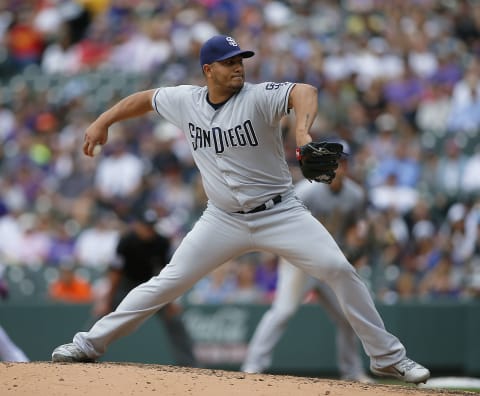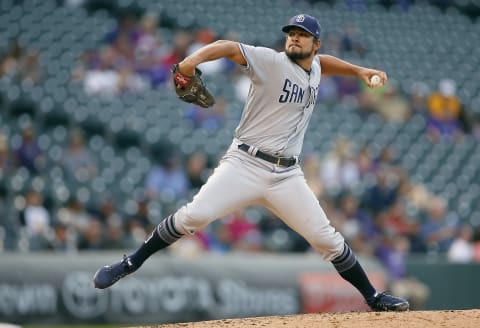San Diego Padres: 2017 Season Review and Offseason Preview


What went right, what went wrong, and what are the top priorities for the San Diego Padres this offseason?
It’s a full-on rebuild in San Diego. The three most expensive contracts the Padres had on the books this year were for players no longer on the team’s active roster (Melvin Upton, Jr., James Shields, and Hector Olivera). The Padres had to eat salary to make up for some bad moves from year’s past. The result was a dirt-cheap roster that struggled to a 71-91 season.
The Padres’ losing season made it seven losing seasons in a row. They did win three more games in manager Andy Green’s second year than in his first but had a much worse run-differential. Based on their negative-212 run-differential, the worst in baseball, the Padres played like a 57-105 team.
A big part of their struggles could be attributed to their young, unproven roster. The average age of their hitters was 26.2, which was nearly two years younger than the Padres hitters’ average age in 2016. The last time the Padres had a group of hitters with an average age younger than this year was in 1981.
The season started poorly, with the Padres winning just eight of their first 22 games. By May 20, they were 15-30 and already 12.5 games out of first. From that point forward they weren’t that bad, going 56-61 over their final 117 games. That might be a good sign for the future.
Here is a look at what went right, what went wrong, and the team’s top offseason priorities.

What Went Right
It’s tough to find a good hitter on the team that scored the fewest runs in baseball. There were only three above average hitters on the roster who had significant playing time. Jose Pirela had the best wRC+ on the team, at 122, which means he was 22 percent better than average as a hitter after league and ballpark effects were taken into account.
Pirela didn’t join the Padres until June. First, he crushed Triple-A pitching by hitting .331/.387/.635 in 48 games with the El Paso Chihuahuas. After joining the Padres, he hit .288/.347/.490 while playing mostly in left field. He also a handful of games in right field, at second base, and at first base.
Center fielder Manuel Margot was a top-100 prospect on the Baseball America list before each of the last three seasons, ranking as high as 24th prior to the 2017 season. As a 22-year-old rookie this year, Margot hit .263/.313/.409 and provided good defense in center field. He also finished second on the team in steals, with 17.
The “ace” of the pitching rotation was Jhoulys Chacin (3.89 ERA, 4.26 FIP in 180.3 innings), who tied for the team lead in starts and had the best ERA of the three pitchers on the Padres who qualified for the ERA title. Clayton Richard (4.79 ERA, 4.23 FIP in 197.3 innings) also tied for the team lead in starts and pitched 17 more innings than Chacin. His ERA was worse than Chacin, but his FIP was better.
The best news out of the Padres bullpen was the emergence of Brad Hand at closer after Brandon Maurer was traded away in July. Hand saved 21 games and struck out 104 batters in 79.3 innings. He could be a useful trade chip.
Before coming to the Padres prior to the 2016 season, Hand split time between starting and relieving with the Marlins. In five seasons, he had a 4.71 ERA and 4.54 FIP in 288.7 innings. In two seasons in San Diego, he has a 2.56 ERA and 3.05 FIP in 168.7 innings. His strikeout rate went from 5.9 strikeouts per nine innings with the Marlins to 11.5 strikeouts per nine innings with the Padres.

What Went Wrong
In 2016, Wil Myers hit .259/.336/.461, with 99 runs, 28 homers, 94 RBI, and 28 steals. He also played a full season for the first time and rated very good defensively. Based on UZR/150, he was the second-best first baseman in the league with the glove. The Padres rewarded him with a six-year, $83 million contract before the 2017 season. It’s the largest contract in Padres history.
His offensive numbers were similar this year, but just a bit down across the board, except for a slight increase in home runs. His defense was another story. He dropped from the second-best fielding first baseman in baseball to 20th. His overall WAR dropped from 3.9 to 0.9.
Another Padre who struggled on defense was Hunter Renfroe. He ranked 19th of the 20 right fielders in baseball who played enough innings to qualify. He also struggled to get on base, with a .284 OBP. He hit for some power, launching 26 big flies, but his overall season was barely above-replacement level.
Catcher Austin Hedges was good behind the plate, but his .262 OBP was one of the reasons the entire Padres team finished with an on-base percentage below .300. They were the only team to do so. Hedges did hit 18 home runs, but he’ll need to be better at getting on base to be an asset to the dish no matter how good he is on defense.
Infielder Ryan Schimpf has taken the fly-ball approach to its extremes. In his two years in the big leagues, nearly 65 percent of his hit balls have been in the air. It worked well for him when he hit .217/.336/.533, with 20 homers in 89 games in 2016. That production made him 30 percent above average, and worth 2.5 Wins Above Replacement (WAR).
The same approach this year didn’t work as well. He still swung from the heels and hit 14 homers in 53 games, but it came with a .158/.284/.424 batting line (88 wRC+). He ended up playing more games in the minor leagues than the majors.
Thirteen different pitchers started at least one game for the Padres, and many of them were not very good. Travis Wood (6.71 ERA, 7.00 FIP) came over from the Royals in a July trade and was awful. Jered Weaver (7.44 ERA, 8.12 FIP) signed with the Padres as a free agent before the season and was even worse than Wood. Miguel Diaz (7.34 ERA, 7.02 WHIP) started three games and appeared in relief in 28 others. He allowed 11 home runs in 41.7 innings.

Top Offseason Priorities
According to CBS Sports, only two teams had a lower payroll than the Padres’ $71 million last year (the Rays and Brewers). Wil Myers was the most expensive position player on the roster, at $4.5 million, and the aging remains of Jered Weaver’s career was the highest-paid pitcher, at $3 million. In fact, a sizeable portion of the Padres’ payroll was going to players no longer on the team, including Melvin Upton, Jr. ($16 million), James Shields ($11 million), and Hector Olivera ($6 million). This is what a full-on rebuild looks like.
Upton, Jr.’s contract is off the books, but the Padres will still be paying Shields and Olivera, along with $2.5 million to Jedd Gyorko, who played this season with the St. Louis Cardinals.
This is how the lineup and rotation look for 2018 based on their current roster, with salaries from Cot’s Baseball Contracts at Baseball Prospectus:
- C Austin Hedges, pre-arbitration
- 1B Wil Myers, $2 million
- 2B Carlos Asuaje, pre-arbitration
- SS Yangervis Solarte, $4 million
- 3B Cory Spangenberg, arbitration-eligible (projected: $2 million)
- LF Jose Pirela, pre-arbitration
- CF Manuel Margot, pre-arbitration
- RF Hunter Renfroe, pre-arbitration
- OF Matt Szczur, arbitration-eligible (projected: $800,000)
- SP Clayton Richard, $3 million
- SP Dinelson Lamet, pre-arbitration
- SP Luis Perdomo, pre-arbitration
- SP Robbie Erlin, arbitration-eligible (projected: $700,000)
- SP Colin Rea, pre-arbitration
- RP Brad Hand, arbitration-eligible (projected: $3.8 million)
- RP Carter Capps, arbitration-eligible (projected: $1.3 million)
- RP Kirby Yates, arbitration-eligible (projected: $1.1 million)
- RP Travis Wood, $6.5 million being paid by Kansas City Royals
- Free agents: SS Erick Aybar, Jhoulys Chacin, Jordan Lyles, Craig Stammen
The Padres have inexpensive players throughout their lineup and pitching rotation, but still, owe departed players around $20 million this year. More than half of that comes off the books after the 2018 season when they no longer have to pay any part of James Shields’ contract. They may open up the checkbook when that happens, but will likely limit their spending in the meantime.
One of their departing free agents they’d like to bring back is Jhoulys Chacin, but they won’t get him for the same one-year, $1.75 million contract he had this year. He’ll be an interesting test case in free agency because of his extreme home/road splits. He had a 1.79 ERA and 3.80 FIP at Petco Park and a 6.53 ERA and 4.85 FIP everywhere else.
Re-signing Chacin would give the rotation another veteran pitcher, along with Clayton Richard, to hold down the fort while the younger pitchers develop. The Padres’ minor league system is top-loaded with pitching. According to MLB Pipeline, seven of their top 10 prospects are pitchers, and the three position players in the top 10 are still two to three years away from big league play.
More from Call to the Pen
- Philadelphia Phillies, ready for a stretch run, bomb St. Louis Cardinals
- Philadelphia Phillies: The 4 players on the franchise’s Mount Rushmore
- Boston Red Sox fans should be upset over Mookie Betts’ comment
- Analyzing the Boston Red Sox trade for Dave Henderson and Spike Owen
- 2023 MLB postseason likely to have a strange look without Yankees, Red Sox, Cardinals
Another priority for Padres GM A.J. Preller is dealing closer Brad Hand. He’s coming off two very good years and has a low salary so he could bring good talent to the organization. The Padres won’t be chasing a playoff spot for a while, so a good, cheap closer is a luxury.
While the Padres continue the rebuild in the hopes of being the Houston Astros sometime down the road, they will play their young position players and see if they develop. Unless they re-sign Erick Aybar, they’ll need a shortstop for the short term because prospects Luis Urias and Fernando Tatis, Jr. aren’t yet ready, and Yangervis Solarte is better used as a utility player.
If the Padres don’t make progress, you have to wonder how long Wil Myers will be around. His contract is heavily backloaded. He’ll make $2 million next year and $3 million in 2019; then his contract escalates to $20 million per year for the remaining four years. If he gets off to a good start next year, the Padres could look to trade him to get out from under the back end of that contract.
Next: MLB Free Agency 2017-18: Biggest Holes for Every Team
Padres fans have endured seven straight losing seasons, and it looks like it could stretch to a decade or so while their young prospects develop. Despite the losing, the Padres were 18th of 30 teams in attendance last year. Hopefully, those loyal fans will be rewarded like the Astros fans were this year.y.